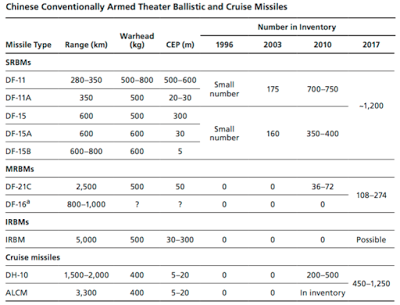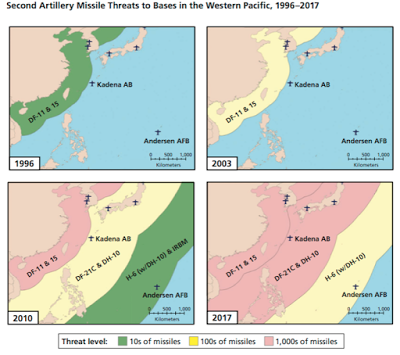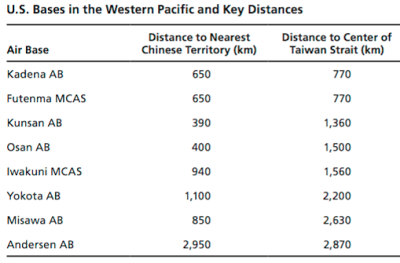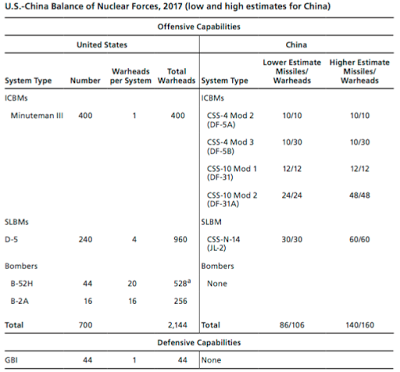
With China and the United States at odds over North Korea, the South China Sea and Taiwan, I wanted to take a look at a comparison of the military strength of both nations. This is particularly pertinent given the following comment from the Global Times, a tabloid newspaper that is owned by China’s ruling Communist Party’s official People’s Daily newspaper after the United States sailed through the South China Sea:
“Analysts believe that recent US military activity is another example of how the US is struggling to maintain the status quo while coping with the rise of China as a global power. They urge the US to face up to the reality that China is becoming a maritime power and that China’s determination to protect its sovereignty should not be underestimated….The US provocation has boosted the chance of military confrontation between Beijing and Washington,” Zhu Feng, director of the Collaborative Innovation Center of South China Sea Studies under Nanjing University, told the Global Times.” (my bold)
A recent study by Rand Corporation does a very neat job of comparing the military strength of the world’s current sole superpower and the world’s up-and-coming superpower, China. The study begins by noting that China’s People’s Liberation Army (PLA) has transformed itself from a large but technologically antiquated military force into a very capable, modern and technologically advanced military. While it still lags the United States in certain areas, China has done an amazing job of arming its military with the latest technology. As well, China’s close geographic proximity to potential Asian theatres of war gives it an advantage over its competitors. Rand’s report analyzes the U.S. and Chinese military capabilities in ten operational areas in four snapshot years; 1996, 2003, 2010 and projected to 2017. This gives us a sense of how the military capabilities of both nations have changed over a two decade period. The scorecards evaluate the capabilities of both militaries in two potential scenarios:
1.) An invasion by China into Taiwan.
2.) A South China Sea – Spratly Islands campaign.
For the purposes of this posting (i.e. to keep it to a reasonable length), I will not examine all ten operational areas rather, I will focus on two aspects; ballistic missile development and nuclear stability.
Let’s look at spending on the military by both nations starting with China. China’s military has evolved a great deal since the 1960s and 1970s when it was designed to protect the nation’s borders. After “peace” was brought to the Korean Peninsula in 1953, China engaged in confrontations with the United States, Taiwan, India, the Soviet Union and Vietnam. With the death of Mao Zedong, China’s Communist Party gradually opened the nation’s economy, giving China access to Western markets, investment, technology and military assistance. Over the years between 1978 and 1996, China’s spending on the military declined from a high of 4.6 percent of GDP in 1978 to 1.0 percent in 1996. After the third Taiwan Strait crisis in 1996 when China conducted both military exercises and missile tests in the vicinity of Taiwan Strait which were meant to signal China’s displeasure at the visit of Taiwanese President Lee Teng-hui to the United States and to intimidate Taiwan in the lead-up to Taiwan’s 1996 presidential election, China’s defense budget began to grow very rapidly and China began to import weaponry from the former Soviet Union. In 2015, China’s official defense budget was $142 billion, however, not all defence-related expenditures are included in their official defense budget with estimates showing that China’s 2010 spending on defense was 45 percent higher than official budgetary numbers. Over the years between 1996 and 2015, China’s annual real military spending growth averaged 11 percent annually with a focus on capabilities to fight a conflict across the Taiwan Strait. This works out to a 620 percent real increase in spending on the military which has outstripped the growth in China’s GDP.
Now, let’s look at the United States. In the case of the United States, military budget increased rapidly after the attacks of 2001 and then declined in the years between 2010 and 2015. The U.S. 2015 defense budget of $560 billion is 57 percent larger (adjusted for inflation) than the budget in 1996. Most of this increase has gone to fund combat operations in the Middle East. One advantage that the United States has over China is its significant stockpile of materiel that is readily accessible for use. For instance, the USAF’s first purpose-built stealth aircraft, the F-117, first operated in 1983. The PLA is just developing its own stealth capabilities, recently testing four prototypes of the J-20 as well as the J-31, however, neither has entered the production phase.
Now, let’s look at two key aspects of China’s military development.
1.) Ballistic Missiles: China has the most active ballistic missile program in the world. The Second Artillery, the branch of the PLA that is responsible for both nuclear and conventional missiles has come a long way since 1996. Back then, the Second Artillery had a handful of DF-15 and DF-11 missiles with limited accuracy. By 2010, the Second Artillery had roughly 350 to 400 DF-15 missiles and 700 to 750 DF-11 missiles, both new variants that have vastly increased accuracy (circular error probable (CEP) of between five and ten metres compared to 300 metres in 1996). Here is a table showing China’s growing inventory of short-range (SRBM), medium-range (MRBM), intermediate-range (IRBM) and cruise missiles along with projections to 2017 estimating China’s inventory of conventionally armed missiles at that time:
Here is a series of maps showing China’s growing capability to threatened U.S. bases with its missiles:
Obviously, as the decades have passed, more and more U.S. bases are in the crosshairs of the Second Artillery. The only U.S. base in the Western Pacific that is not currently threatened by China’s conventional ballistic missiles is Andersen AFB on Guam, however, it is in range of China’s nuclear-armed DF-3 IRBM. China has announced that it is developing a 4000 km range IRBM that is conventionally armed which will enter service between 2016 and 2019.
The challenge facing the United States in the Western Pacific is the fact that there are only two U.S. airbases that are located within U.S. fighters unrefueled combat radius of the Taiwan Strait (i.e. less than 1000 kilometres). China has 39 airbases within 800 kilometres of Taipei, the capital of Taiwan. Here is a table showing the U.S. airbases in the Western Pacific and the distance to the nearest Chinese territory and the Taiwan Strait:
To summarize, if China were to threaten Taiwan by neutralizing U.S. Air Force Bases in the Western Pacific, China’s advances in ballistic missile technology since 1996 will give China the advantage over U.S. forces in the region by 2017. As well, if a conflict over the Spratly Islands in the South China Sea were to develop, China’s ability to neutralize U.S. bases in the region have been greatly improved since 1996, putting China’s capabilities on par with the United States by 2017.
2.) Nuclear First Strike Stability: China conducted its first nuclear weapon test back in 1964 and has maintained a force of fewer than 250 nuclear warheads since that time. It has a much different attitude toward the efficacy of nuclear weapons, preferring to use them to dissuade other states from using nuclear weapons against China rather than using them as a first-strike weapon. Given that, the authors of the report looked at China’s first-strike stability; the ability of both China and the United States to absorb a first strike by the other side and still launch a second, retaliatory strike. In general, states that cannot absorb a nuclear first-strike tend to develop more nuclear weapons, hoping that they have sufficient inventory to respond.
If we look back to 1996, China had 19 strategic nuclear weapons that could target the United States’ nuclear assets, none of which were capable of a successful first strike compared to the United States which had more than 7600 nuclear warheads deployed across a wide range of delivery systems including silos, submarines and manned bombers. The authors of the report estimate that by 2017, China will have between 106 and 160 warheads and the United States will have 2144 nuclear warheads, greatly reduced because of the U.S. commitments to the START treaty.. China currently appears to store all of its nuclear warheads in depots, separate from launchers during peacetime meaning that China is more susceptible to a nuclear attack than the United States where nuclear warheads and launchers are a single unit.
Here is a table showing the projected nuclear balance in 2017:
The authors estimate that in a “low case” where China has only 106 warheads, that they could destroy 1146 American warheads and their delivery systems or 53 percent of the U.S. total. In the “high case” where China has 160 warheads, only 1156 American warheads would be destroyed, largely because the only U.S. targets left to strike after attacking major nuclear-capable bomber bases and ports are Minutemen III silos which only contain a single nuclear warhead each. Even with the growth in China’s nuclear capabilities, the United States would still be able to destroy most Chinese targets, however, the number of surviving Chinese nuclear weapons has increased from four in 1996 to six in 2003, thirteen in 2010 and between fifteen and twenty-seven in 2017. Not only have the number of surviving Chinese missiles increased over time, so has their reliability. As well, by putting increasing numbers of weapons on mobile platforms, China may be able to better protect its nuclear assets from an outside attack.
Let’s summarize the findings of the entire report, comparing China’s capabilities in 1996 to their capabilities in 2017:
1.) China’s PLA has made major strides in its capabilities, particularly in ballistic missiles, fighter aircraft and attack submarines.
2.) Chinese military gains have not been uniform and some areas of improvement have been matched by the United States.
3.) China’s ability to control a conflict beyond its geographic borders are improving.
4.) China has not caught up to the United States in terms of its aggregate capabilities, however, it is quite capable of dominating its immediate periphery (i.e. Taiwan and the South China Sea).
Overall, the trends are working against the United States when one compares the military capabilities of China to U.S. military forces. One of the biggest problems facing the United States military is the legacy of military commitments that it has acquired around the world after more than two decades of being the world’s only superpower. In two of the most recent examples, Iraq and Afghanistan, combined costs of $1.5 trillion through to the end of 2014 have meant that the U.S. military has revamped itself as a counterinsurgency force rather than a military that is capable of fighting a conventional war, the most likely scenario should hostilities develop in either Taiwan or the South China Sea.
Click HERE to view more.
You can publish this article on your website as long as you provide a link back to this page.





Be the first to comment